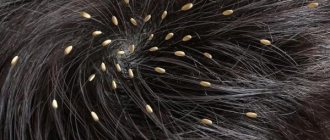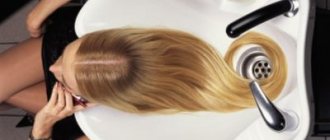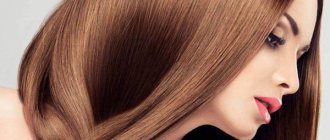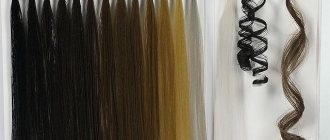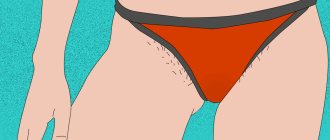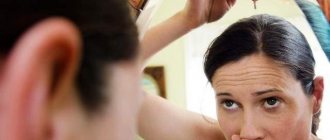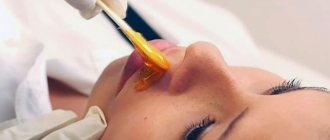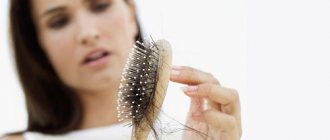procedures "
The hairline on the forehead can have a different shape, which is determined at the genetic level. It is she who influences how the chosen haircut or hairstyle will look. Unfortunately, it does not always improve the appearance of the hairstyle. Is it possible to adjust the hairline to achieve the perfect hairstyle?
What types of lines are there?
First of all, you should determine what lines actually exist and how to understand which line you own? Everything is very simple. Lightly dampen your hair and comb it to the back of your head using a comb. The forehead and temples should be as open as possible. Now look in the mirror and determine what type of hairline you have. If you can’t do this yourself, take an eyeliner and carefully outline the hairline at the top of your forehead. Look in the mirror again and evaluate the result.
So, there are 5 types of face framing in total:
- M. The M-shaped hairline on the head is quite common in both men and women. It consists of fairly high bald patches, separated by an “island” of hair right in the center.
- V. A rarer line shape, reminiscent of the letter V, due to a pronounced triangle with an acute angle.
- Rectangular. A smooth stripe without “islands” with slightly pointed corners on the sides of the face. This line occurs in men much more often than in women.
- Arch. It is this form that is considered ideal among all types. According to legend, women with such a hairline are the happiest in their personal lives. The arch is a soft semicircle with a slightly narrowed top.
- 3 arches. An unusual and extremely rare form that occurs in a small percentage of people.
Silhouette Definition
If the hair loss is significant, then the silhouette of the upper part of the head gradually takes the shape of a skull, that is, it becomes close to spherical. Because of this, individuality is lost: this is why patients who have lost a lot of hair are so similar to each other. The sphericity of the resulting silhouette can be eliminated by replacing it with a new one formed by transplanted hair, which enters at a certain angle (depending on the area of the skull).
Three-dimensionality is achieved by ensuring the relationship between the vertical and horizontal growth lines. For the front half of the skull, the angle can be 30-60° forward, for people with natural “bangs” - less than 30°. To create a flattened appearance, the hair shafts being transplanted can be placed at an angle back. The presence of your own hair in the treated area usually allows you to use this option without fear, except in cases where the patient has a cowlick.
Simple correction
This type includes options such as bangs, special styling, hair gel, plucking, shaving and lightening.
If you are the owner of very large bald spots, then the easiest way to hide them is styling. To do this, choose hairstyles such that the hair on the sides of your face is loose. In this case, you will not have to resort to radical measures. Avoid high, slicked-back hairstyles such as a high ponytail or bun.
For women with pronounced triangles, it is recommended to have a haircut with bangs. If the problem with the line is very obvious, then it is best to keep the bangs straight. Its length doesn't matter.
Another way to remove a triangle from your hair is to comb it. However, the hairs themselves are unlikely to be held in an unnatural position. To make the comb last, use hair gel or mousse. Apply a small amount to your hands and rub into your hair. Next, use a comb to comb them back.
For those whose hair grows in a small triangle or “island” in the center of their forehead, we suggest trying to lighten it with hydrogen peroxide.
Apply a little liquid to a cotton pad and hold it on the problem area for a minute or a little more. By doing the procedure daily, you will see that your hair becomes lighter every day. However, this method is only suitable if the hairs are not hard and long.
How to change the direction of hair growth on your head
There are several reasons why the growth line may be in the wrong direction:
- Two central cowlicks on the top of the head.
- The presence of two centrifugal diverging strands forming a natural parting.
- The presence of a centrifugal converging strand, which makes the entire hairstyle bristle. Most often it happens on the back of the head.
- Natural cowlick, in any part of the head except the crown.
- Vortex stars. They especially interfere if they are close to the edge line. In this case, it is problematic to trim the bangs, because they will stick out in different directions.
When such features appear, the risk of improper growth increases, which causes inconvenience when styling and choosing a haircut.
Luckily, there is a way to get your hair to grow in the right direction.
For this you will need:
- comb;
- hair dryer;
- styling (styling product);
- heat protectant;
- bobby pins or other durable hairpins.
It is advisable to do the procedure during the day. You need to apply a heat protectant to your hair and start styling it in the desired direction using a hairdryer and comb for 10-15 minutes. At the end, fix the styling with styling and hairpins in the desired position, and continue like this until the evening. If it is not possible to come to work or a business meeting with such a hairstyle, you can postpone the procedure to the evening.
To obtain the desired result, it will take 2 to 6 months of effort. The main thing is to carry out the procedure every day.
Hair plucking
The next very popular method of combating unsightly hairlines in women is plucking with tweezers. Having identified the most problematic area, wipe it with a piece of ice to avoid or at least reduce subsequent pain. Now take tweezers and pluck out one hair at a time, thereby adjusting the shape. Of course, this process is not quick, but it is quite effective.
After all, when a hair follicle is removed, hair most likely will not grow in this place. And if it grows back, it will be softer and less noticeable, which, in general, is also not bad. This method is good because it does not require financial costs or any equipment, since tweezers can be found in the arsenal of any woman.
From peeling to transplantation
A revolution in the treatment of alopecia was made by drugs containing minoxidil, a vasodilator that, when used regularly, can not only stop baldness, but also restore lost hair. However, there are a number of patients for whom this remedy is ineffective.
For example, it often does not work on men with fibrosis and inflammation in the hair follicles, as well as hyperplasia of the sebaceous glands. For such patients, peelings and physiotherapy (microcurrents, low-intensity laser) are more effective. Physiotherapy has an anti-inflammatory effect, and also improves nutrition and microcirculation in the growth zone of hair follicles.
Question answer
How long does the rehabilitation process after hair transplant take?
If all else fails, the last resort remains - autotransplantation (hair transplantation from donor growth zones where hair does not fall out (this is the back of the head) to where it is sparse). On average, such an operation costs about 100 thousand rubles.
Shaving hair
Another way to get rid of unsightly hairs along the growth line, which is used by many women. This method differs from plucking in that after shaving, the hairs will grow with renewed vigor. Moreover, it is darker and thicker. If you need to trim your hairline once or twice, then perhaps a razor has its place. But if you want to get rid of an ugly growth line for a long time, then you should look for another way out.
To shave the unwanted area, it is best to use a small razor for delicate areas and shaving foam. To avoid shaving off excess hair, divide your hair into two parts: necessary and unnecessary. Using any convenient method, remove the hair that should remain intact. And try to comb the rest onto your forehead. Apply foam to this area and shave with gentle movements.
About the benefits of caffeine
Prevention is the most effective and simplest way: regularly using special therapeutic and cosmetic products, you can simply prevent baldness from developing.
One of the active ingredients in medicinal shampoos and lotions is active caffeine. This was proven by the research of the German trichologist Adolf Klenk. Caffeine blocks the damaging effects of dehydrotestosterone on hair roots, supplies hair with additional energy, prolongs its growth phase and stimulates the root. But just drinking coffee is useless, because to get the required concentration of caffeine, you will have to drink 50 cups of the drink a day. And rubbing coffee grounds into your head can cause skin irritation.
How to hide bald spots using folk remedies
If you are not satisfied with the marginal hairline due to bald patches on the sides, then we recommend increasing the hairline in this area using folk remedies.
Pepper tincture. One of the most effective means for enhancing hair growth. Apply to a cotton pad and wipe through hair roots and scalp. As soon as the product starts working, you will feel a burning sensation.
Burr oil. Lightly heat the oil in a metal container in a water bath. Apply to slightly damp hair, rubbing into problem areas. Next, put the bag on your head and wrap it with a towel to create a thermal effect. After 20 minutes, rinse with warm water and shampoo. Do an oil mask 2 times a week to achieve hair growth.
A nicotinic acid. Another universal and inexpensive remedy that will help cope with receding hairline. Acid should be rubbed onto the scalp in those places where there is insufficient hair growth.
Why doesn't hair grow on the sides of my head?
If hair does not grow on the sides of the head since childhood, then this can be a congenital feature, and when it appears in adolescence or adulthood, it is one of the signs of hormonal imbalance, lack of vitamins, and changes in the tone of the autonomic nervous system. To stimulate growth, a diet containing enough zinc, copper, vitamins and special compounds - furocoumarins - is indicated. The following products are useful:
- liver;
- squid, mussels, shrimp;
- fresh greens, broccoli, lettuce;
- oranges, grapefruit, lemon;
- figs;
- celery;
- oatmeal and buckwheat porridge, pearl barley, millet.
Topical application of a solution of Minoxidil and nicotinic acid is recommended. In some cases, the endocrinologist prescribes hormonal drugs, since this form of hair growth is often accompanied by an excess of male sex hormones. The following procedures are recommended in cosmetology clinics:
- manual or hardware massage of the scalp;
- darsonvalization - exposure to an electrode in the form of a comb with alternating current discharges;
- mesotherapy – local subcutaneous injections of vitamins, hormones, caffeine and other hair growth stimulants;
- oxygen and ozone therapy – a mixture of ozone and oxygen is injected under the skin to restore metabolic processes and activate blood flow;
- laser shower on the scalp;
- microionization – medicinal substances are introduced into the skin using microcurrents;
- galvanic peeling – serums with a peeling effect are applied to an electrode in the form of a comb; it is often used before applying hair growth stimulants for deeper penetration;
- ultrasound exposure and administration of medications (phonophoresis);
- electrical stimulation – carried out by electric pulse currents;
- cryotherapy - massage with an applicator soaked in liquid nitrogen.
If medications and physical therapy have no effect, then a hair transplant is prescribed.
Radical measures
If you have tried all of the above and did not see the desired result, then laser correction remains. It is suitable only for those who want to get rid of unnecessary hair along the hairline. Before the procedure, the patient undergoes an examination and a mandatory consultation with a doctor. Today, laser surgery gives excellent results. It passes quickly and painlessly for the patient.
Using special equipment with a laser, the doctor directs the device to the desired area and literally makes a flash in a second. After several such procedures, the hairs completely disappear. And what’s remarkable is that new ones don’t grow. However, the price of this method of hair removal is quite high. But what won’t you do for the sake of beauty!
Use any option convenient for you to correct your forehead hairline to get closer to your ideal and become a more confident woman.
The hairline is closely related to. If angular
, then the hairline will be the same. A person with this type of forehead will likely be practical, gifted, and sociable. He has a disciplined, practical mind. However, he has no artistic streak. A woman with such a forehead prefers housework rather than housework.
In which both lateral hairlines converge, making the upper hairline much shorter than the previous type, indicates that the person has an unhappy family background. Such a person submits to outside pressure and may be under constant stress. In such cases, the person should try to correct this negative situation by taking a more confident and courageous position.
is a sign of artistic temperament and great . Such people are able to excel as artists, musicians, writers and scientists. Giving free rein to his passion, such a person may discover incongruous anger or joy. He is also indifferent to the future, has no business acumen and prefers a bohemian lifestyle.
Women with a hairline similar to the M-shape, but much smaller and more pointed, belong to the chaste and virtuous type. They are feminine and value consistency in life. They also love household chores.
Often women have a round ear line
. This indicates a liberated spirit and an independent thinking mind. Angular hairlines can be found on enterprising women and female employees. Such women are always ready to compete with men as equals.
With frayed edges, forming a jagged outline, indicates a difficult childhood and a neurotic personality in later years. Often such a person is sullen and rude and often rebels against society.
Most people with a jagged hairline have low intelligence. But a word of caution is necessary here. This conclusion does not apply to people who have a well-shaped forehead, wide and fairly even, despite an irregular hairline. Facts from history show that many rebellious people, despite their jagged hairline, had high intelligence.
Receding hairline
or a receding hairline occurs when the hair begins to thin out and gradually fall out, the skull is gradually exposed. It is known that not all people experience baldness. Those who have such a lot are distinguished by a good and potentially creative mind. ______________________________________________________________
There is no woman who would be indifferent to her appearance. Visiting a hairdresser to get your hair done is a common occurrence. But sometimes difficulties arise when it suddenly turns out that one or another form of styling is hampered by short hair on the forehead, which sticks out and does not fit into the overall composition. This is especially noticeable when everything is combed back, without leaving bangs.
Should you be upset about this and how, if necessary, to remove excess hair from your forehead, is discussed in this article.
The presence of short and thin hair on the forehead of women is quite common, and it is very noticeable to others. If you have a calm attitude towards the very fact of their presence, you shouldn’t be upset. You can choose a hairstyle that will hide the growth line at the top of the forehead and completely forget about this problem.
It’s another matter when the short hair that appears on the forehead begins to transform and grow intensively, covering an increasingly larger area. In this case, you should immediately address this problem.
There are many ways to do this - from professional ones, performed by specialists in beauty salons, to folk ones, which can be used at home.
Before deciding what exactly should be done if hair grows on the forehead, you need to visit a cosmetologist who will help remove it, and consult a doctor to determine the cause of this problem.
Why does hair grow on the forehead?
The question of why small hair grows on the forehead has two main answers:
- heredity;
- hormonal changes.
As a rule, women of the East, having dark hair, deal with the problem of hair growth not only on the forehead, but also above the upper lip.
And if earlier this was considered a sign of an imperious character, now, of course, few people are happy, especially among unmarried girls.
The appearance of facial hair can be a consequence of a hormonal surge. In this case, the first thing to do is consult a doctor.
Did you know?
Hair growth depends on the functioning of the gonads, which produce hormones. If male hormones predominate, then facial and body hair increases significantly.
Hairline
This line is individual for each person, but there are several basic forms:
- rectangle - predominates in men and represents a clear horizontal line in the upper part of the forehead;
- in the shape of the letter M - the hair grows in a triangle, creating a small pointed protrusion with bald patches above the temporal region;
- arch - a smooth curved line emphasizing the height of the forehead;
- heart-shaped - resembles two arches connected by the edges in the center;
- three-arch form - is a curved row consisting of three arches connected together.
Some fashionistas strive to achieve one of these shapes by removing the fuzzy border. Sometimes this is easy to do, but it also happens that implementing your idea will require a lot of time, effort and money spent.
Important!
Before correction, you should have a clear idea of what result should be achieved. Remove all excess - or, conversely, make longer and thicker strands in certain areas.
Should I delete
Removing excess hair on the forehead is a purely personal matter for each person.
It all depends on the character, type of activity, sensitivity to the opinions of others.
Among women
Most of them are inclined to radical solutions, but perhaps simpler actions will be enough:
- form bangs that can cover problem areas;
- release curls or strands in places that should be covered;
- comb your hair in a certain way;
- do the styling in the desired direction and fix it with varnish.
After all, in a young girl or teenager, this may be a temporary phenomenon.
For
men,
the presence of excess hair is never particularly painful for them. A man will most likely have a question about how to grow hair on his forehead, because the stronger sex is prone to baldness.
Did you know?
Women are not prone to baldness, since the roots of their hair are planted 2 mm deeper than those of men.
In children
There are no problems at all, because babies grow, develop, change, so today's problems can disappear tomorrow on their own.
In addition, from infancy, a child has certain areas covered with soft fluff, which disappears forever over time.
How to get rid of short hair on forehead
When thinking about how to get rid of unwanted hair on your forehead, the first thing that comes to mind is to pluck or shave. But these are not the best options.
At home
When deciding how to hide or remove small hair on the forehead without resorting to the services of specialists, you can consider the following options:
- Carry out bioepilation.
Either resin is used. When heated, they are applied to the problem area and covered on top with a sheet of special paper. After everything has cooled down, you should tear off the sheet with a quick and sharp movement. - Lighten with hydrogen peroxide.
A 3% or 6% solution will be required; It is used every second day to treat the area that needs to be lightened. With prolonged use of this method, the complete disappearance of unnecessary vegetation is possible. - Treat with an alcohol solution
(medicinal alcohol 35 g, ammonia 5 g, castor oil 5 g). Lubricate twice a day. - Rub with nut shells.
Walnut or pine nut shells are crushed and diluted with water to form a paste. Rub problem areas 3-4 times a day. - Apply an infusion of nettle seeds.
Add forty grams of powdered seeds to one hundred grams of vegetable oil and leave in a dark place for about two months. After straining, use daily as a lubricant 2-3 times a day. - Lubricate daily with freshly squeezed juice of green (unripe) wild grapes.
- Use a soda solution
(a teaspoon of soda per glass of boiling water). A cotton swab is moistened in the solution, which is applied to the desired area and remains in effect throughout the night.
Visit to a cosmetologist
This is the wisest decision, especially if the problem area has a significant area.
A good specialist, with extensive experience, will be able to accurately determine the reason why hair has grown on the forehead and suggest how to most effectively hide or remove unwanted hair in each specific case.
Important!
Bleaching, which can be done independently and at home, will be safer and more effective if this procedure is performed by a cosmetologist.
Hairline correction: how to correct it on the forehead, temples, using laser, transplantation, removal
The hair growth boundary is determined by the shape of the forehead, its size, and facial proportions. And if they are not perfect, there are ways to correct the flaw. The most win-win is surgery. You can also use a laser; there are also less radical methods.
What is a line, its types
Main types of hairline :
- of the letter M. There is one lowest point in the central part of the line. To the right and left of it, the hair growth boundary diverges into triangles.
- In the form of a rectangle . This form is more common in men. The central segment of the border is straight, the side segments are also straight, but they are shorter. All components have clear contours.
- In the form of a semicircular arch . This shape is more suitable for women, as it makes the face softer.
- In the form of the letter V. In the central part of the line is the lowest point. From there, the hair growth line goes to the temples.
- In the form of three arches . The line of the beginning of the scalp consists of semicircles. The central one is larger than the side ones. This form is the rarest.
There are also asymmetrical variants and disturbances in the shape of the line after skin injuries.
We recommend reading about hair transplant methods. You will learn about surgical hair transplantation, sutureless, patchwork methods, long hair transplantation, contraindications to the procedure. And here is more information about the options for hair transplantation on the head.
Marginal hairline: diagram
A schematic representation of the marginal hairline is shown in the figure. It passes through the protrusions and notches on the forehead, temples, and descends behind the ears to the cervical notch.
Is it possible to change the direction of hair growth?
The direction of hair growth is determined at the genetic level, but with the help of styling products and constant combing in the right direction, you can gradually change it a little. It will not be possible to completely correct it, since the hair follicle has an innate angle at which it is located in relation to the skin.
How to change the direction of hair growth on your head
Styling products can help change the direction of hair growth:
- mousses,
- foams,
- varnishes
- gel,
- wax,
- retainer,
- special lipstick,
- modeling clay.
Every day you need to comb your hair in the desired direction, fix it with the chosen product and pin it with clips. The more often and diligently you do this, the better results you can achieve, but the first effect should be expected after about 1 month.
How to straighten the hairline on your forehead
To straighten the hairline on the forehead, use:
- hair removal with tweezers,
- laser correction (spot destruction),
- electrocoagulation (an electrode is inserted into the hair follicle),
- shaving,
- bleaching with hydrogen peroxide or special lightening agents,
- stimulation in areas where growth is insufficient - laser, treatment with nicotinic acid, pepper tincture, minoxidil-based preparations (Regaine, Alerana, Generolon), castor or burdock oil.
Visually help line alignment:
- applying shadows with a wide brush to match the hair tone, but 2 shades lighter,
- overlap with bangs, side strands when styling,
- the use of fixing agents (varnishes, foams) so that the vellus hair along the edge does not get out of the hairstyle.
How to get rid of forehead hair
To get rid of forehead hair, temporary and radical methods are used. The first includes shaving, plucking with tweezers or an electric epilator, wax strips or a depilator for the facial skin. Daily wiping with a cotton swab with hydrogen peroxide, to which 5 drops of ammonia and 2 drops of liquid soap have been added (per 5 ml) can help make them less noticeable.
For the second, that is, for a lasting effect, laser removal is used. If the skin is light, then photoepilation is recommended. There is a method of removal by electric current - electrolysis. This is a salon procedure; there are also home portable devices, but the results from their use may be weaker.
Why doesn't hair grow on the sides of my head?
If hair does not grow on the sides of the head since childhood, then this can be a congenital feature, and when it appears in adolescence or adulthood, it is one of the signs of hormonal imbalance, lack of vitamins, and changes in the tone of the autonomic nervous system. To stimulate growth, a diet containing enough zinc, copper, vitamins and special compounds - furocoumarins - is indicated. The following products are useful:
- liver,
- squid, mussels, shrimp,
- fresh greens, broccoli, lettuce,
- oranges, grapefruit, lemon,
- figs,
- celery,
- oatmeal and buckwheat porridge, pearl barley, millet.
Topical application of a solution of Minoxidil and nicotinic acid is recommended. In some cases, the endocrinologist prescribes hormonal drugs, since this form of hair growth is often accompanied by an excess of male sex hormones. The following procedures are recommended in cosmetology clinics:
- manual or hardware massage of the scalp,
- darsonvalization - exposure to an electrode in the form of a comb with alternating current discharges,
- mesotherapy – local subcutaneous injections of vitamins, hormones, caffeine and other hair growth stimulants,
- oxygen and ozone therapy – a mixture of ozone and oxygen is injected under the skin to restore metabolic processes and activate blood flow,
- laser shower on the scalp,
- microionization – medicinal substances are introduced into the skin using microcurrents,
- galvanic peeling – serums with a peeling effect are applied to an electrode in the form of a comb, often used before applying hair growth stimulants for deeper penetration,
- ultrasound exposure and administration of medications (phonophoresis),
- electrical stimulation – carried out by electric pulse currents,
- cryotherapy - massage with an applicator soaked in liquid nitrogen.
If medications and physical therapy have no effect, then a hair transplant is prescribed.
Indications for hairline correction
The desire to make the face harmonious forces people to change the upper border of the forehead. But it should be adjusted according to indications, otherwise there is a risk of getting the opposite of the expected result. Changes are made in the following cases:
- the hair growth boundary is unevenly outlined, there is asymmetry,
- it is necessary to make the forehead more feminine (indication applies to representatives of the fairer sex and for feminized transvestites),
- harmonization of facial proportions requires a different shape of the hairline,
- forehead too high
- bald patches have formed on it,
- the forehead is too low, which gives the face a gloomy appearance,
- there is a lot of vellus hair on it, disrupting the regular outline.
In the case where the shape of the forehead has deteriorated due to alopecia, correction will be only one of the stages in improving the area. After all, it will not stop further baldness. And the patient will have to combine it with hair transplantation, treatment by a trichologist, endocrinologist.
Surgical method to correct the line
The forehead can be made lower in accordance with other facial proportions through surgery. The tissues of the scalp are mobile, so they are moved down or up, left and right. In most cases, the operation is performed under general anesthesia or local anesthesia with sedation. The intervention consists of several stages:
- after the patient receives painkillers and antiseptic treatment of the skin, an incision is made along the hairline,
- a piece of skin on the forehead is removed,
- the upper border moves down,
- tissues are fixed in a new position with the help of endotins,
- A suture is placed on the incision, a plaster and a bandage are placed on top.
The operation lasts up to 2 hours. With its help, it is possible to move the problem line by 5 cm or more.
Laser for forehead correction
Thermal radiation will help improve the hairline for both high and low foreheads:
- If it is narrow, laser hair removal is performed. Radiation in several sessions will get rid of excess hair, weakening its follicles. The laser procedure is done in 15, 20 minutes; it will help to even out the upper border of the forehead, hiding bald spots, eliminating the unsightly little toe in the center. With its help, the shape of the hairline is changed to a more suitable one. To achieve the effect, 4-8 sessions are needed with pauses of 3-4 weeks.
- If the forehead is too high, a low-intensity, “cold” laser can be used. Radiation stimulates the growth of vellus hair at its upper border. It awakens “dormant” follicles, increases blood circulation in this area, supplying the bulbs with oxygen, and promotes cell development. This stimulates hair growth, increases its density, allows you to correct the shape of the forehead and reduce its height.
The procedures are done twice a week for 3-6 months. They are absolutely painless.
Watch this video about laser hair removal of the forehead area:
How to stimulate roots
You can turn short hair on your forehead into full-length hair using home methods. They improve the nutrition of the bulbs, stimulating growth. For this use:
- "Minoxidil" . This is a drug used for focal baldness. The composition is rubbed into the skin at the hair growth border twice a day. Course of use – from 3 months to a year. The main disadvantage of the drug is its high price. But its effectiveness is very high.
- Nicotinic acid. The vitamin product is sold in ampoules. The liquid is also rubbed into the skin several times a day. It is odorless and does not get dirty, so you can use it at any time of the day.
- Mustard mask (2, 3 times a week). To prepare it you need 2 tbsp. l. powder, the same amount of hot water and burdock oil. Add to them 2 raw yolks and 2 tsp. Sahara. The mixture is applied to the skin and left for 20 minutes. If the burning sensation is severe, you should wash it off earlier with warm water. Mustard increases blood supply to hair follicles, which stimulates growth.
- Pepper tincture. It works similarly to mustard, but it is bought at the pharmacy. Apply to the skin with a cotton pad and leave for 20, 30 minutes.
- Burdock and castor oils. They can be used alternately, every other day. Or carry out a course of treatment first with one remedy, then with another. Oils are not just applied on top, but rubbed into the skin of the forehead for several minutes. You should be careful with castor oil. If there is too much of it, hair, on the contrary, will begin to fall out.
Laser hair growth stimulation
To activate dormant hair follicles, laser stimulation of hair growth is prescribed. On the forehead line it is shown at a high level, receding hairline, asymmetry. It takes the form of irradiation with special devices (low power is needed). The session lasts about 30 minutes. The course requires from 5 to 10 procedures.
How to lower your hairline
You can lower your hairline (up to 5 cm) through surgery. It includes the following steps:
- incision along the growth border,
- excision of part of the skin,
- fixation in the desired position,
- cosmetic stitch.
For pain relief, general anesthesia or, less commonly, local anesthesia is used.
Watch this video about methods for stimulating hair growth:
Hairline correction price
Depending on the method of hairline correction, the price of treatment varies, but the average levels are as follows:
- surgery (lowering or raising the border of the scalp) – from 70,000 rubles, 19,000 hryvnia,
- laser hair removal – 500 rubles per 1 session, 200 hryvnia,
- laser stimulation – 5000 rubles, 1500 hryvnia for 1 procedure,
- hair transplant for 1 pc. – from 70 rubles, 20 hryvnia.
It should be taken into account that the cost of procedures is significantly influenced by the category of the clinic.
We recommend reading about eyebrow transplantation. You will learn about indications and contraindications for the procedure, eyebrow hair transplant techniques, recovery and aftercare, and results.
And here is more information about what the face looks like before and after frontoplasty.
We hide flaws without intervention
An unaesthetic hairline on the forehead can not be eliminated, but simply hidden using:
- Bangs. It can be made oblique or straight, short or up to the eyebrows. In any case, the defect will not be visible.
- Loose voluminous curls. This method is suitable for those who have thick hair.
- Hair fixation products. Foam or varnish will help style the strands so that the unsightly forehead line will be hidden.
The hairline is not the most visible part of the face, but its lack of aesthetics can cause problems. Fortunately, they can be solved; if necessary, you should use one of the methods for correcting the upper forehead line. And it won't necessarily be an operation.
To learn about correcting your hairline using cosmetics, watch this video:
Loading…
Source: https://marykay-4u.ru/plasticheskaya-hirurgiya/komu-i-kakaya-pomozhet-korrekcziya-linii-rosta-volos
What will happen and what to do if you shaved the hair on your forehead
If a girl shaved her forehead hair once, she will have to repeat this procedure in the future. There is nothing particularly terrible about this, because most women constantly shave their legs, preferring this method to others, since it is convenient and painless for working with a large area. But in the case of the forehead, it is better to choose another method.
If for some reason this happens, the next step in the fight against problem areas should be a trip to a cosmetologist, and in especially severe cases, to a doctor.
How to remove short hair on forehead forever
It is best to consult a cosmetologist about this, who will professionally tell you how to permanently remove problematic hair growing on the forehead in the wrong place.
TV presenter Victoria Bonya talks about how to correct the shape of the forehead:
Proven methods used in beauty salons are:
- Laser hair removal.
The impact of a laser beam on the follicle, which leads to its destruction without restoration. - Photoepilation.
Under the intense influence of heat and light, follicles are destroyed. A universal, but time-consuming remedy. - Electrolysis.
Under the influence of electric current, each hair is completely destroyed within 30 seconds.
Determination of density
Hair transplantation allows you to change its density, for example at the interface. When creating a density gradient, specialists use three parallel lines, located at a distance of 4-5 mm from each other, as a guide. This also allows for a smooth transition from skin to hair.
- The first zone is the absolute interface and the beginning of the transition zone. It includes areas of individual hair of low density (10-15 pieces per 1 cm2), shaped like elongated triangles.
- The second zone is individual hair, located symmetrically and having a higher density (25-35 per 1 cm2).
- The third zone is two follicular units of high density (40-60 per 1 cm2), located symmetrically.
Using this method allows you to create natural differences in density. Usually, its increase is carried out during the following sessions, since it is quite difficult to achieve a hair density of more than 60 pieces per 1 cm2 within one session.
Remove or discolor
Every woman has the right to decide this issue independently. The only advice can be only one - do not rush to extremes, making rash decisions.
Based on the above, it becomes clear that if it is possible to do with only bleaching, you should choose this option. In case of serious problems, do not hesitate to contact a specialist. A cosmetologist will tell you how to remove all excess, and the doctor will indicate the cause of this problem.
The forehead is one of the secondary features of the face, since it frames its upper part and is the background for the perception of the main features. Determining character by the forehead is not particularly difficult, because it is the forehead that personifies its main features. Those people who claim that “everything is written on the forehead” are not so wrong! The forehead can tell about a person’s intellectual abilities, his career successes, intuition, etc.
Occupying the entire first stage of the face, the forehead characterizes a significant period of a person’s life: from thirteen to thirty years. It is during this period of life that a person’s character develops.
In order to learn how to determine character from the forehead, it is necessary to carefully study its shape and size, including the contour of the hairline.
So much for AHA
There is an opinion that a bald skull in a man is an indirect sign of high testosterone levels. This is wrong. Hair follicles do not react to testosterone itself, but to its derivative, dehydrotestosterone. At the same time, the level of the main male hormone may be at a modest level.
Question and answer Does cutting a haircut to zero affect the frequency and speed of hair renewal?
The main cause of hair loss is genetic predisposition. If all of a young man’s relatives went bald early, it means that the same fate most likely awaits him. This problem is scientifically called “androgenetic alopecia” (AGA). But when a genetic predisposition develops largely depends on lifestyle. This, by the way, was confirmed by observations of identical twins. Having the same genetics but leading different lifestyles, these people went bald at different ages.
If you want to preserve your hair, you should contact a trichologist as soon as possible. After all, correcting the initial stage of alopecia is easier than growing hair where there hasn’t been any for ten years.
Forehead and character
In profile, the forehead can be flat or convex; in the front view, it can be in the shape of a quadrangle, circle, long or with a sharp top; and in size, the forehead can be low, medium or high, as well as narrow and wide.
1. High, rectangular forehead
Owners of this type of forehead are distinguished by their extraordinary intelligence, practical acumen, determination, calmness, common sense and prudence, and excellent organizing abilities.
2. High round forehead
Such a forehead indicates a quick temper, developed imagination, originality of judgment, ability for exact sciences, but the spiritual callousness and coldness of its owner.
3. Medium-height, oval-shaped forehead
People with this forehead shape are romantics and dreamers, gifted with creative imagination, extraordinary abilities and intuition.
4. Low, flat forehead
A forehead of this type speaks of perseverance, stubbornness of character, a person’s hard work and difficulties in life, since in youth there will be no material support from parents and loved ones.
5. Low rounded forehead
Owners of this type of forehead, as a rule, have a difficult childhood and difficulties in the initial period of their career.
6. Forehead, slightly sloping back
This type of forehead reveals an impressionable nature with a strong imagination, sharp mind and artistic abilities.
7. Backward Forehead
Such a forehead is evidence of the originality of the mind, creativity of thinking, ardor of imagination, eccentricity of behavior and independence of judgment.
8. Convex forehead
Owners of this type of forehead are distinguished by tenacity, stubbornness, silence, and limited thinking.
Hairline and character
Characteristics of a person can be identified by the hairline that borders the forehead from above.
Hair growing in a triangle on the forehead is called “widow’s peak” in the West because of the widespread belief that its owners are destined for early widowhood.
There is a completely different attitude towards this feature of appearance in China: this triangle on the forehead is called Peak of Beauty or Peach Bud. Owners of this element of appearance are characterized by such character traits as romanticism, self-centeredness, and the ability to stand up for themselves.
Bald patches on both sides of the forehead speak of the artistic nature, broad outlook, desire for creation and creativity of their owners.
A broken forehead line indicates a person’s ambition and organizational skills.
An uneven hairline indicates a person’s contradictory character. By removing stray hairs, you can make it smoother.
From a psychological point of view, an open forehead evokes trust and respect, so it is not recommended to cover it with bangs. If bangs are still necessary, it is better to keep them sparse.
Surgical method to correct the line
The forehead can be made lower in accordance with other facial proportions through surgery. The tissues of the scalp are mobile, so they are moved down or up, left and right. In most cases, the operation is performed under general anesthesia or local anesthesia with sedation. The intervention consists of several stages:
- after the patient receives painkillers and antiseptic skin treatment, an incision is made along the hairline;
- a section of skin on the forehead is removed;
- the upper border moves down;
- tissues are fixed in a new position with the help of endotins;
- A suture is placed on the incision, a plaster and a bandage are placed on top.
The operation lasts up to 2 hours. With its help, it is possible to move the problem line by 5 cm or more.
Moles on the forehead and character
Moles have always been given symbolic meaning.
The location of a mole on the forehead on the right side indicates a person’s desire to increase intelligence and comprehensive personal development.
A mole on the left side of the forehead indicates a person with a weak will, who can easily succumb to the influence of others and often commits extravagant acts.
A mole located in the area of the right eyebrow indicates a person capable of deep feelings and a long life together with his chosen one.
A mole located near the left eyebrow speaks of the sensual nature of a person who does not listen to the voice of reason and often makes rash acts and mistakes in choosing a life partner.
The owner of a mole in the third eye area has excellent intuition, logical thinking and a predisposition to study occult sciences.
Character based on the forehead can be easily determined thanks to physiognomy - the art of reading the face, known back in the 5th century BC.
Website All rights reserved. Reprinting of the article is permitted only with the permission of the site administration and indicating the author and an active link to the site
When assessing your susceptibility to male pattern baldness (or androgenetic alopecia), there are a number of risk factors to consider, including your age, family history of baldness, steroid use, and prostate enlargement. Notice the appearance of an M-shaped hairline on the forehead and in the middle of the crown. Monitor how much hair remains on the pillow after sleep and on the comb when combing. Consider other possible causes of baldness, such as poor diet or iron deficiency anemia. To establish an accurate diagnosis, consult a trichologist.
Interesting
How hair grows
The anagen (active growth) phase normally lasts 6–7 years. The shorter this stage, the closer the baldness.
Catagen phase (transition from growth to resting stage) – 2–3 weeks.
The telogen phase (rest) should last 2-4 months. At this stage, hair that has outlived its useful life falls out and a new growth cycle begins. But with AGA, the telogen phase lengthens and can last not 2-4, but 10 months or even several years! The longer this phase, the more pronounced the baldness.
In healthy people, 80-90% of hair is in the anagen stage, 1-2% in the catagen stage and 10-15% in the telogen stage.
Balding. 12 surefire ways to stay hairless Read more
Steps
Part 1
Study of risk factors
- Consider your age.
The risk of developing male pattern baldness increases significantly with increasing age. Your age is one of the main risk factors for baldness (along with heredity and hormonal imbalances). Almost two thirds of men begin to notice signs of baldness by the age of 35, and this figure increases to 80% in men over the age of 50. As such, you should consider your age and relate it to the hair loss you experience. Although male pattern baldness can begin in a very young person (but it is rare), it becomes more likely as people get older. Sudden hair loss in a teenager or young adult is usually associated with a disease, medical treatment, or exposure to toxicity (more on this later).
Pay attention to your maternal and paternal relatives.
It is just a common myth that the tendency to go bald is inherited only on the maternal side and that you can suffer from baldness if your mother's father was bald. Yes, geneticists in this case claim an 80% chance of baldness, but you have the same chance of going bald if your father or paternal grandfather was bald. Basically, you need to look at your father, grandfathers, uncles, and cousins (all immediate male relatives) and determine how thick their hair is for their age. If your relatives experience baldness, ask when this process began. The more relatives you have with baldness, the higher your risk of developing male pattern baldness.
- Only one of the several genes responsible for baldness is passed exclusively from mother to son, but the remaining genes are passed on in the usual way, so a bald father can also have a bald son.
- Baldness occurs when the hair follicles in the scalp dry out over time, causing thinning and shortening of the hair. Eventually, hair stops growing from the atrophied follicles, although the follicles themselves remain alive.
- Understand the effects of taking steroids.
Taking sex hormones (androgens) is also one of the main causes of male pattern baldness. The main blame in this case lies with the hormones testosterone and dihydrotestosterone (DHT). Testosterone is converted to DHT by an enzyme found in the sebaceous glands of the hair follicles. With too much DHT, hair follicles begin to dry out, making it impossible to maintain and grow healthy hair. The main problem may be excessive testosterone levels and/or increased sensitivity of the scalp hair follicles to DHT. Excessive sensitivity to DHT is mainly genetic, but can also be caused by elevated DHT levels due to steroid use, especially in young people who are building muscle mass for bodybuilding and athletic physique purposes. Thus, long-term use of anabolic steroids increases the risk of baldness by up to 100%.
Understand the connection between baldness and prostate enlargement.
An enlarged prostate gland (prostate) may also create an increased risk of developing male pattern baldness.
Benign prostate enlargement becomes more and more common with increasing age and is also associated with the level of DHT in the body. Thus, if you are experiencing symptoms of an enlarged prostate and
suspect that you are beginning to experience baldness, then most likely it is not a figment of your imagination, because both problems are associated with increased levels of DHT.Part 2
Identifying signs of the onset of male pattern baldness
- Keep an eye on the hairline on your forehead.
- You can monitor your hairline by comparing your reflection in the mirror and a photograph of yourself at a younger age.
Male pattern baldness usually starts in the front right at the hairline. In most cases of male pattern baldness, the hairline gradually recedes and begins to take on an "M" shape, with the temples thinning faster than the central section of hair. Gradually, the hair becomes thinner and shorter, and horseshoe-shaped bald patches appear on the sides of the head. Their appearance is a sign of an advanced stage of baldness, and in some men this stage can even end in complete baldness.
The appearance of an M-shaped hairline is a hallmark of male pattern baldness, as the temples (and crown) are usually the most sensitive to DHT levels in the body.
- However, some people do not develop an M-shaped hairline, but a semi-circular one, where the hair recedes evenly from the forehead without leaving a ridge in the center.
In addition to thinning and thinning of hair at the front of the hairline, the same process can occur at the top of the head. Sometimes the thinning of the crown precedes the retreat of the front hairline, sometimes it occurs later, and sometimes it occurs simultaneously. As already mentioned, the hair follicles on the top of the head are sensitive to DHT levels, and noticeably more so than the hair areas above the ears and on the back of the head.
- To check the condition of the hair on the top of your head, you will need to hold a hand mirror to the top of your head and look at it through a stationary mirror. Alternatively, you can have someone take a photo of the top of your head. To assess the degree of hair loss, compare photographs of the top of your head from different times.
A sign of possible thinning and thinning of the hair on the crown when viewed from the front can be a flatter appearance at the top of the hairstyle.
A little daily hair loss is considered normal and is usually replaced by new hair regrowth, while active hair loss results in noticeable and irreplaceable hair loss. Keep your pillowcases clean and monitor how much hair sheds during your night's sleep (take photos to document your observations). If you lose more than a dozen or so hairs per night, you should be concerned. When combing, first completely clear the brush of hair and inspect it after combing. The combing procedure naturally provokes more hair loss (especially when it is long), however, the appearance of more than a few dozen hairs on the brush cannot be considered normal, since this is already a symptom of the process of baldness.
- If you have dark hair, sleep on light-colored pillowcases to make lost hair more visible. Conversely, use dark pillowcases with light hair.
Using hair conditioner after washing your hair makes it easier to comb, which helps reduce hair loss when combing.
Male pattern baldness is the most common cause of hair loss in men, but there are other causes for the problem, including the following: endocrine system disorders (pituitary gland, thyroid gland), poor nutrition (especially protein intake), fungal infections, iron deficiency anemia, excess vitamin A or selenium, excessive use of medications (particularly retinoids and anticoagulants), and anti-cancer treatments (chemotherapy and radiation therapy).
To be sure that you have male pattern baldness, make an appointment with a trichologist (a dermatologist who specializes in treating the scalp). Typical male pattern baldness can usually be diagnosed by a simple visual examination and analysis of the hair loss pattern. However, the doctor will also ask you about your relatives and their tendency to go bald (particularly on your mother's side) and will carefully examine your skin using a densitometer (a special magnifying device) to assess the degree of shrinkage of the hair follicles.
- Diagnosing baldness does not require a hair structure analysis or scalp scraping.
In this case, the doctor will introduce you to all possible methods of treating male pattern baldness, and not just medication courses or hair transplantation.
Treatment
To determine the type of alopecia and its stage, you will need to consult a trichologist. Using a dermatoscope, he will examine the condition of the scalp and hair follicles and tell you what tests you need to take. A smear will be required to rule out fungal infection. This is done even if the clinical signs do not correspond to a fungal disease. Biochemical blood tests and serological tests will be required to identify defects in the immune system, infections, and vitamin deficiencies.
Physiotherapeutic procedures
Due to the lack of accurate information about the mechanism of development of alopecia areata, it is often difficult to understand how to cure it. Usually a combination of several popular techniques is used. Medication therapy and physiotherapy will be required. Many people also need the help of a psychologist, psychotherapist, or neurologist.
The most commonly prescribed procedures are:
- Electrophoresis. Medications are injected into the scalp using weak electrical currents. This method of treatment allows minimal doses of medication to effectively affect the affected areas of the skin. Medicines administered in this way are more effective and last much longer. The advantage of the method is the ability to administer several medications at once. The average course required for the treatment of alopecia areata is 10 sessions.
- Mesotherapy. Cocktails are injected into the skin. The injections contain amino acids, copper peptides, and vitamin B.
- Phototherapy. Using infrared radiation, they stimulate metabolic processes in the scalp.
- Aeroionization. Exposure to a flow of air charged with ions.
- Galvanization. The damaged areas are exposed to weak current discharges. Thanks to this, the functioning of the endocrine system is restored, the required amount of useful elements is produced, thanks to which the hairline is restored more actively. Pregnant and lactating women and people with malignant neoplasms should not resort to the procedure.
- Darsonvalization. The affected areas of the skin are exposed to high-frequency alternating current. As a result, the blood supply in the alopecia area is activated, the vessels become more permeable, as a result the follicles receive adequate nutrition and new hair shafts appear. Typically, 10-15 sessions of darsonvalization are prescribed, and if necessary, repeat therapy after a month.
- Laser therapy. The technique is based on the use of ultraviolet and infrared rays. Ultraviolet light warms the skin, stimulating vasodilation and improving the functioning of the sebaceous glands. Baldness stops, pathogenic microorganisms are destroyed. Infrared rays affect the skin, improving tissue nutrition, stimulating blood circulation and the formation of new cells.
Medicines
To treat alopecia areata, the doctor chooses various drugs. The most commonly used tablets, injections, ointments, and lotions based on corticosteroids. They suppress the immune system, which reduces the destructive power of autoimmune effects.
Effective drugs:
- Minoxidil. The drug in the form of a solution leads to vasodilation. As a result, blood flow improves, the follicle is more intensively supplied with nutrients and oxygen.
- Finasteride. A hormonal agent that can suppress the substance that converts testosterone into dihydrotestosterone, which negatively affects the condition of the hair. Indicated exclusively for men.
- Diprospan. Suspension in ampoules based on betamethasone. Eliminates inflammation and allergic reactions. The drug is administered subcutaneously.
- Cutivate. Therapeutic product produced in the form of a cream. Helps fight inflammatory and allergic processes.
- Isoprinosine. Tablets with antiviral and immunostimulating effects.
- Sandimmune-Neoral. A drug that suppresses the immune system. Reduces the aggressive effect of one’s own immunity on the follicles.
Additionally, antihistamines, antiviral agents, immunomodulators, and vitamin complexes are prescribed. The course of treatment must be completed in full. If the patient stops therapy prematurely, after a while the hair will begin to fall out again.
